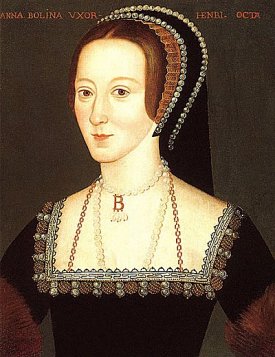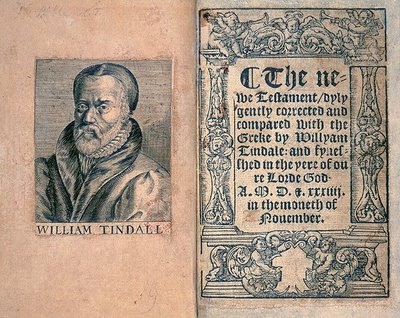Anne Boleyn has chiefly been remembered as the wife who was falsely accused of betraying Henry VIII and getting beheaded. But not so well known about her is that she was considered to be the “patron saint” of the Reformers, who were being persecuted at the time.
betraying Henry VIII and getting beheaded. But not so well known about her is that she was considered to be the “patron saint” of the Reformers, who were being persecuted at the time.
Anne Boleyn was born in 1507. She was educated in France. Her mentor was Marguerite d’Angouleme, later Queen of Navarre. In another place on this blog, you can read about Marguerite and her influence on the Reformation in Europe.
Remember, Henry VIII broke with Rome and formed the Church of England in order to legitimize his marriage to Anne Boleyn when the Pope would not grant him an annulment from Catherine of Aragon, his first wife. Henry, who waffled back and forth between Catholic and Reformed, depending on what he wanted, was willing to embrace some Reformed teaching in order to get his first marriage annulled and marry Anne Boleyn. Anne’s wedding and coronation took place in 1533.
Anne only reigned for about three years, but she was a catalyst for the Reformation in England. She was the one who encouraged Henry to make the break. She protected and encouraged the first Reformers. Looking back in history, we can see that once the Reformation started, it was unstoppable.
Anne’s emphasis was on reform, not on just breaking away from the traditional faith. Like many, she did not see why a break had to be made with Rome, if only some changes could be made for the better. For example, she saw the danger of items such as bread or water becoming objects of worship rather than just symbolic elements. Many people in her day treated them in a superstitious way, attributing power and miraculous events to them. She did not want to do away with the Biblical elements of water for Baptism or bread for Communion, just put them in their rightful place as symbols.
Anne believed that the Bible should be translated into English and made available to  common people instead of just the clergy. She convinced her husband, King Henry, that William Tyndale, who was a follower of Luther, was the king’s supporter and friend. This was quite a feat, since Henry despised Luther.
No religious heretics were burned at the stake during the period of time that Anne was queen. However, after her death, Henry VIII had others tried and executed. (See the story about Anne Askew elsewhere on this blog.) We can only speculate on how many lives Anne saved.
common people instead of just the clergy. She convinced her husband, King Henry, that William Tyndale, who was a follower of Luther, was the king’s supporter and friend. This was quite a feat, since Henry despised Luther.
No religious heretics were burned at the stake during the period of time that Anne was queen. However, after her death, Henry VIII had others tried and executed. (See the story about Anne Askew elsewhere on this blog.) We can only speculate on how many lives Anne saved.
In her personal life, Anne was very generous and put her religion into her everyday practice. Anne distributed a fortune in charity among the English people. It has been estimated that she distributed more than £1500 per year to the poor alone. You have to multiply by about 1000 to get to today’s equivalent. So, that would be £1,500,000 or about $3,000,000. Much of this money came from the church lands that Henry confiscated.
Thousands and thousands of people received assistance of some sort from Anne throughout her reign. She also sewed clothing with her own hands for distribution to the poor, and was known on at least one occasion to have personally tended to the ill on her travels. One famous story tells of a certain parishioner who lost most of his cattle. When Anne visited the parish she interviewed the man’s wife and gave her a gift of £20. (Remember this would be like $20,000 today.) Few of her biographies mention her charitable acts at any length, and these were also not much publicized during her own lifetime. After her death of course, many people were busy trying to forget her, mostly because they did not want to displease King Henry. Historians have since vindicated Anne and new books have been published proclaiming what a remarkable woman Anne truly was.
Anne saw to it that her own court was run frugally. Her household was to be ordered on the grounds of equity, justice and value for money. Her staff was required to attend chapel daily and to avoid brothels and any other place of ill repute.
Anne was a generous supporter of education. She made personal contributions to Oxford and Cambridge Universities. She founded a new grammar school with fee-paying and free places in the collegiate church of Stoke by Clare.
Anne was considered by most of her contemporaries to be extremely intelligent, witty and charming. In addition, it appears that she had a rather droll, sense of humor. As an example, her most famous quote was spoken prior to her execution when she was amiably chatting to someone about her executioner. Reassuring the friend (and probably herself) that all would go well, she said, “I hear he’s quite good. And I have a very small neck!” Then she touched her neck and laughed “greatly”. She also referred to herself in the tower as “Queen Lackhead”. She was said to always enjoy a good laugh even, it would seem, at her own tragic end.
The events leading up to Anne’s downfall are somewhat controversial. There were others who wanted more power for themselves, waiting to bring her down. There was also the fact that Henry VIII did not yet have the son he wanted. He had divorced Catherine of Aragon and married Anne in hopes of getting that son. Anne had only given him a daughter, the future Elizabeth I. Anne had had three miscarriages, including one that was definitely a boy. People were superstitious at that time. Perhaps Henry thought that Anne was bad luck. More probably, he couldn’t wait to try out another wife. He married his third wife, Jane Seymour, only eleven days after Anne’s execution.
As in several other places on this blog, we see how God used a woman in a high place, with much influence to help spread the Gospel. I believe that Anne died innocent of the charges of treason against her, and truly served God to the end of her days. It has been said of her, “Anne understood her providential mission to be this: to bring the Reformation to England and employ every single instance of patronage and influence to that end. Her self-confidence and bearing aided the Protestant cause immeasurably. In fact, it was through Anne that the New Religion entered England.”

